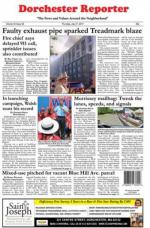June 1, 2023
The 1970s prepared me for the issues we face in the current era. The Wall Street Journal has confirmed that office landlords across the country are filing abatements, seeking relief from their property tax assessments which were premised upon much higher occupancies, much higher rents’ and lower interest rates.
Boston, or any jurisdiction in Massachusetts, is dependent upon property taxes for a far greater percentage of total revenues than in other parts of the country. The number in Boston is over 70 percent. About two-thirds of those revenues come from non-residential properties. It is possible that, if commercial values are reduced, more of the burden will fall upon those who live in the city who have had relatively low property taxes for decades.
Nicholas Blum, an economist at Stanford, is predicting reduced business activity in the billions of dollars. It’s really quite simple – fewer people, fewer lunches, fewer dinners, less shopping, reduced property values, less taxes. Professor Stijn van Nieuwerburgh of Columbia University’s Graduate School of Business projects a significant decrease in commercial real estate values as a result of the huge shift in work patterns in US cities.
Professor Arpit Gupta of NYU’s Stearns School of Business suggested that there could be an “urban doom loop.” If, as he predicts, commercial property values will be reduced by 40 percent, we are all in trouble. He sees an “office real estate apocalypse” ahead.
These articles I have referenced were all written long before the banking crisis that many expect will drag commercial real estate values down even further. My contemporaries at City Hall thought the 1970s were bad, but we did not have that far to topple!
That is why I have suggested, on more than one occasion, the need to proactively market Boston – both its downtown and its neighborhoods. It is essential that we work with business groups, including the Downtown BID and the Greenway BID, to engage in the types of boosterism that other communities have successfully undertaken. People who are restaurateurs have explained to me that lunch is busy Tuesday, Wednesday, and Thursday and absolutely dead the rest of the week. Accelerated tourism is needed to prop up those businesses that have survived.
What is our future? Is remote work a good thing for younger people, or for any of us? Some have suggested, given that so many people are working in part from home, that “hybrid places – where people work and also live and play” will recover more quickly. Some have suggested the future of work “is undefined.” There is great uncertainty as to what a “workplace” means anymore, or what workplace attire means, if it means anything at all. I would not want to be a manufacturer of ties.
Those of us who are committed to Downtown Boston remaining the center of commerce for New England need to encourage residential conversions of those downtown buildings that can be successfully retrofitted. Difficult though it is for someone who has been coming downtown on a daily basis for over 50 years, 9-to- 5 commuters are less central to the future of downtown.
When I ran for mayor of Boston 40 years ago, I gave a speech entitled “The 24-Hour City.” To create a 24-hour city downtown, we must change laws regarding liquor licenses. For Boston to recover, there must be more people downtown. They may not be the same people as before, but they will eat and drink and listen to music. However, people will not come into a city at all until the random violence taking place - with limited visible police presence - is addressed.
We must transform our Downtown Business District into a place where people not only work, but also live and gather to enjoy parks and entertainment venues.



